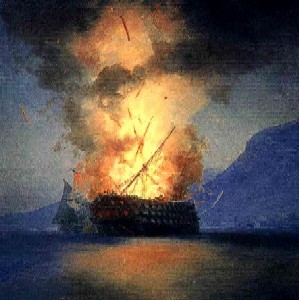
Treating Burns Page Selection Menu: 1 2 3 4 5 6 7 8 9 10 Next>>
Treating Burns During the Golden Age of Piracy, Page 2
Dangers of Non-Battle Fire Shipboard

Artist: Pierre-Julien Gilbert
Combat de La Cordelière devant Saint-Mathieu (1838)
"This Person [Taylor, a pirate ship's Master] spared no pains to extinguish the Fire in the Hold’ and tho’ they were scalded in a sad manner by the Flames, yet they never shrunk till it was conquered; which was not till near ten a clock at night, when they came upon Deck, declaring the Danger was over: So the Surgeons were called to dress their burns. This was joyful News to us all on Deck, for we little expected to escape." (Captain William Snelgrave, A New Account of Some Parts of Guinea and the Slave Trade, p. 272)
As suggested on the previous page, a ship during the golden age of piracy was particularly susceptible to fire and the men were constantly aware of this danger. Let's begin by looking at some examples culled from period sources of the potential causes of fires outside of what were encountered in battle.
Candles
"[Nov 13, 1678] But we had like to have had a bad supper; for a little before 7 the Master left his candle burning in his cabin, which fired a bunch of rosemary, and had like to have fired the ship". (Henry Teonge, The Diary of Henry Teonge, Chaplain on Board H.M.’s Ships Assistance, Bristol, and Royal Oak, 1675-1679, p. 228)
The primary source of light after dark was a flame, and seamen being human
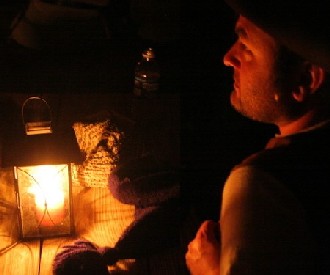
Photo: William Pace
The Author, With Candles Safely Ensconced in a Lantern
(not to mention inclined to drink when the opportunity presented itself, making them a bit careless) were sometimes guilty of using candles outside of a lantern as well as leaving them burning unwatched.
The 4th Article of Bartholomew Robert's published rules for behavior on his pirate ships stated that "The Lights and Candles to he put out at eight o'Clock at Night: If any of the Crew after that Hour still remained inclined for Drinking, they were to do it on the open Deck"1. In fairness, it goes on to say the Roberts imposed this article because he "believed [it] would give a Check to their Debauches, for he was a sober Man himself"2, but it can readily be seen that this might have a two-fold purpose in preventing possible fires.
Certainly pirate captain John Phillips Articles bears this concern out. The sixth Article states that anyone who carried "a Candle lighted [in the hold of the ship] without a Lanthorn" would be punished by receiving 39 lashes "on the Bare Back"3.
There were several reports of fires caused by ill-attended candles from the accounts of period sailors. Edward Barlow talks about a fire caused by the "burning of a candle in a man’s cabin, he falling asleep and forgetting to put it out... [the ship, being full of black powder, was a place where] the snuff of a candle causeth all to be turned into a blast, and in a moment no hopes of any person’s lives being saved, from death in the twinkling of an eye."4 He also reported of the Reall ffrenshippe that "in the year 1669 she was burnt by accident, by [someone] leaving a candle burning in the hold"5.
Barlow later tells of 'a sudden accident at twelve at night' in 1691 when the ship he was on was reported to be "a-fire; and indeed there was a great smoke caused by the negligence of some of our men, having been drinking
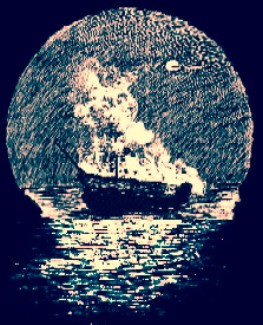
Artist: Frederick Ehrlich(1902)
Ship Afire from Pirates and Piracy by Oscar Herrmann
and left a candle burning in a cabin on the lower gun deck, which took hold of some loose oakum [tarred fiber used to caulk the joints of timbers], but did no harm."6 Although nothing came of it, he revealed the concern among the men about this, explaining that "the noise of fire is very dreadful in a ship, some of our men being ready to slip overboard, having on board above 400 barrels of gunpowder and 100 guns."7
James Yonge reports in his memoirs that a quartermaster "left a candle burning in his cabin, which took fire, and had not our chyrurgeon's son, who lay with a broken leg in my cabin, being almost chokd with a the smoke, made shift to crawl up and cry Fire, she had been in a flame before any one could know it"8.
In the introduction to his book of sailor's Journals, Bruce Ingram cites Dawtry Cooper's report from 1630 which gives a vivid account of what happens when men were careless with their candles shipboard. "This woeful accident befel His Majesty's pinnace the Seventh Whelp. My gunner's mate, not knowing what combustion he might have with that Hollander [a ship they had taken], hasting to lade [load] that piece again, came carelessly down into the powder-room to fetch a cartridge and took a candle without a lantern and therewith set fire to all and blew up the ship, which in an instant sunk downright, and with her I lost 48 as able seamen and officers as ever sailed in her, of which sad number there was a son and a nephew of my own who were right dear to me, and such as would have proved apt for His Majesty's service"9.
1 Captain Charles Johnson, A general history of the pirates, 3rd Edition, p. 231; 2 Johnson, ibid.; 3 Johnson,p. 398; 4 Edward Barlow, Barlow’s Journal of his Life at Sea in King’s Ships, East and West Indiamen & Other Merchantman From 1659 to 1703, p. 60-1; 5 Barlow, p. 141; 6 Barlow, p. 414; 7 Barlow, ibid.; 4 James Yonge, The Journal of James Yonge [1647-1721] Plymouth Surgeon, p. 50; 9 Bruce S. Ingram, Three Sea Journals of Stuart Times, 1936, p. xxii
Smoking
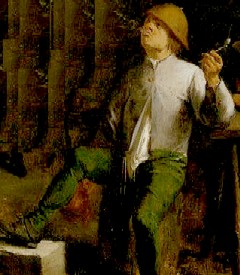
Artist: Adriaen Brouwer
The Smoker (early 17th. c.)
Smoking is actually not often cited in period accounts as the cause of setting a ship alight, which is surprising given that it appears to have been a very common recreational activity amongst sailors. Still, it must have been a matter for concern. In addition to addressing the dangers of candles, John Phillips Article six also warns that any "Man that shall snap his Arms, or smoak Tobacco in the Hold, without a Cap to his Pipe" would be punished with those same 39 lashes.1
Edward Barlow, while listing the troubles the average sailor faced at sea (something he was rather fond of doing) gives us a mournfully poetic passage on this topic. "Neither are ships and we poor seamen out of great danger of our lives in calms and fairest weather, for the least fire may set a ship on fire, many ships having been burnt by some careless man in smoking a pipe of tobacco"2. Unfortunately for our discussion, he doesn't cite any specific examples of this, so all we can do here is take him at his word that 'many ships' were so lost.
1 Captain Charles Johnson, A general history of the pirates, 3rd Edition, p. 398; 2 Edward Barlow, Barlow’s Journal of his Life at Sea in King’s Ships, East and West Indiamen & Other Merchantman From 1659 to 1703, p. 60
Cooking and Utility Fires
Special brick-lined
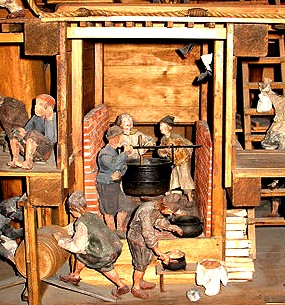
Photographer: Peter Isotalo
A Model of the Galley of the 17th c. Warship Vasa
rooms in a ship were constructed for setting fires to be used for cooking, making medicines and ship repair preperations and other, similar uses. The bricks were to protect the ship from the danger of the fires kindled therein. Even so, when a ship was in battle or was traveling quickly, the cooking fires were not lit, such was the concern for accidentally burning a ship because of sudden movementt.
Barlow reports that one fire was the result of the "carelessless of the cook in not putting the fire well out at night ...and by burning of brandy and other strong liquors"1. [Barlow may have been referring to the process of rectifying liquors in that last part. This was sometimes done by physicians and surgeons to create medicinals such as aqua vitae.]
Maintenance of the ship could also be a potential source of fire hazard. Barlow details the troubles of an admiral on the Monmouth frigate in 1668, which " was in danger of being on fire, for having scraped the ship's side, in heating or melting of rosin and tallow together to do over it, the kettle being too full and a great fire under it, it boiled over into the fire and ran about the deck in a flame, being very dangerous, yet it was put out before it could do any great harm, all the ships in the [Ligorne or Leghorn] Road supposing she had been on fire."2
1 Edward Barlow, Barlow’s Journal of his Life at Sea in King’s Ships, East and West Indiamen & Other Merchantman From 1659 to 1703, p. 60; 2 Barlow, p. 161
Chafing Dishes
Chafing dishes were used to heat coals red hot

Artist: Rembrandt
Beggar Seated Warming His
Hands at Chafing Dish (1630)
for warming as well as to burn things to perfume the air. Materials such as "a tarred piece of rope, tobacco, or gunpowder was used to overcome the evil odors" below decks1 because air was widely believed to be the source of illness by period physicians. Such a procedure might also be used for healing patients 'infected' by bad air. John Woodall suggested that the scent "of Frankensence and pitch, being cast upon burning coales, and the Patient set close over the fume, helpeth presently" in the case of Tenasmus2 - a rather vicious sort of constipation.
We have one period account of a ship being set alight by a chafing dish. It is once again given by merchant seaman Edward Barlow. Barlow reported that arriving in Tangiers Road in 1669 he heard "how one of the King's ships was burnt in the river of Chatham by accident; for the gunner lying on board and having his wife on board, and it being the same winter that we were in the Straits, and it being cold weather, they having in the cabin a chafing-dish of coals along with them to warm themselves by, and going to bed and leaving them (the coals) carelessly in the night, they took fire in the cabin and set the ship on fire, and so the ship called the Defiance was burnt, the King losing a good ship"3. Interestingly, rather than using this as evidence of the dangers of fire, Barlow blamed it on "having women on board and to be pleased with what they want, they being such ----- evils, doing more harm than good wheresoever they come."4 [Note: I suspect the left out word was 'damned' although it's just a guess.]
1 Zachary B. Friedenberg, Medicine Under Sail, p. 35; 2 John Woodall, the surgions mate, 1617 Edition, p. 224; 3 Edward Barlow, Barlow’s Journal of his Life at Sea in King’s Ships, East and West Indiamen & Other Merchantman From 1659 to 1703, p. 171; 4 Barlow, ibid.
Powder Storage
Black powder was something of a necessary evil on a ship. It was required for an effective battle during the golden age of piracy, so it was needed to be shipboard. In addition to the obvious dangers of its use during warfar - which will be discussed shortly - there was also an inherent danger to storing the powder. This was why even pirates had rules about bringing open flames and smoking pipes around powder. Still, stored powder sometimes blew up in inexplicable circumstances. Edward Coxere gives such an account, in rich detail. I have added a paragraph break to the account for readability.
…of a sudden the powder took fire in the gun-room and a sad blow was given, so that we seemed to be nothing but fire
Artist: Ivan Constantinovich Aivazovsky
An Exploding Tall Ship (1900) and smoke and expected to have been blown up into the air in a moment. So dreadful was it that the men which could swim leapt over board into the sea to swim to the boats that were at the stern of our ship. Everyone shifting for their lives, among the rest I was not a little concerned, but sufficiently scared, for my life lay at stake and it was 'Everyone shift for himself'; the captain was then no more regarded than the cook. I was got on the top of the stern of the ship, I perceiving the men made to the boats, got over the stern to get down by a rope into the boat, but by the way my foot got foul of something which was like to have proved very much to my damage, the men making such way to get into the boats to save their lives.
But it so happened that I got clear and got into the boat, where the captain soon got after and, the boatful of men, we soon rowed the boat from the ship, where we looked on with sorrowful hearts, expecting they that were aboard would a been blown up every minute…. The boats being put off from the ship, they were in danger both of fire and water, two bad masters, and no help they had but by heaving of water, till at last it pleased the Lord that they overcame the fire before it got to the main powder-room. All this while we who were in the boats did not dare come nigh the ship, for the guns fired off with the fire which was burning. Some lost their lives and about seventy were carried ashore at Portsmouth in a sad condition, so burnt as was sad to behold.1
4 Edward Coxere, Adventures by Sea of Edward Coxere, p. 7-9
Drowning
In addition to the normal problem of people being burned, there was a side-effect of shipboard fires: drowning. Edward Barlow explains that while sailing to Ireland in 1691, they were overcome with "thick, hazy, misty weather, [after which] one of our ships, the St. Michael by name, having such another
accident in that passage by neglect of some fire or candle carelessly left near the powder rooms, which presently caused the alarum, several men being struck with that fear of being blown up that they presently
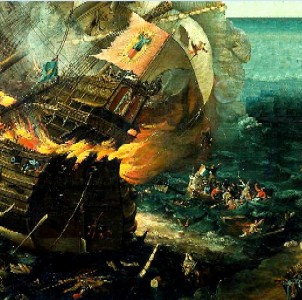
Artist: Cornelis Claesz van Wieringen
Explosion of the Spanish Flagship - Battle of Gibraltar (1622)
leaped overboard; and before any could come to take them up were, several of them, drowned in the sea; but it pleased God the fire was soon extinguished."1
As amazing as it may seem, many sailors and even ship's captains could not swim. This even surprised some writers from the period. As Captain George Roberts explained to a group of men who had swam aboard his incapacitated vessel from shore, "I told them, I could not swim; at which they much admired, that any Man should venture to go to Sea without knowing how to swim."2 This meant that when fire broke out on a ship, such men had to decide what they wanted less - to be burned by flames or choked with water.
Merchant captain Nathaniel Uring gave an account of facing this problem when he found himself on a burning ship. "The Fire grew so fierce in an Instant, there was no coming near it: The Wind blowing fresh, it encreased prodigious fast, and in a few Moments the Upper Deck and Gunhills [gunnels - the uppermost timber bend on the side of a ship], as far as the Chesstrees [upright timbers on the ships side between the fore and main mast], were all in a Blaze. …I must of Necessity have perished in the Flames, or been drowned, for I could not swim, neither could I come near the Place where the Lanyard was fastened to have hauled to the Boat, for the Violence of the Flame, which reached beyond it."3 One can't help but wonder how many men faced this same situation without finding a convenient boat in which to escape.
1 Edward Barlow, Barlow’s Journal of his Life at Sea in King’s Ships, East and West Indiamen & Other Merchantman From 1659 to 1703, p. 416; 2 George Roberts, The four years voyages of Capt. George Roberts, p. 149; 3 Nathaniel Uring, A history of the voyages and travels of Capt. Nathaniel Uring, p. 6-7

